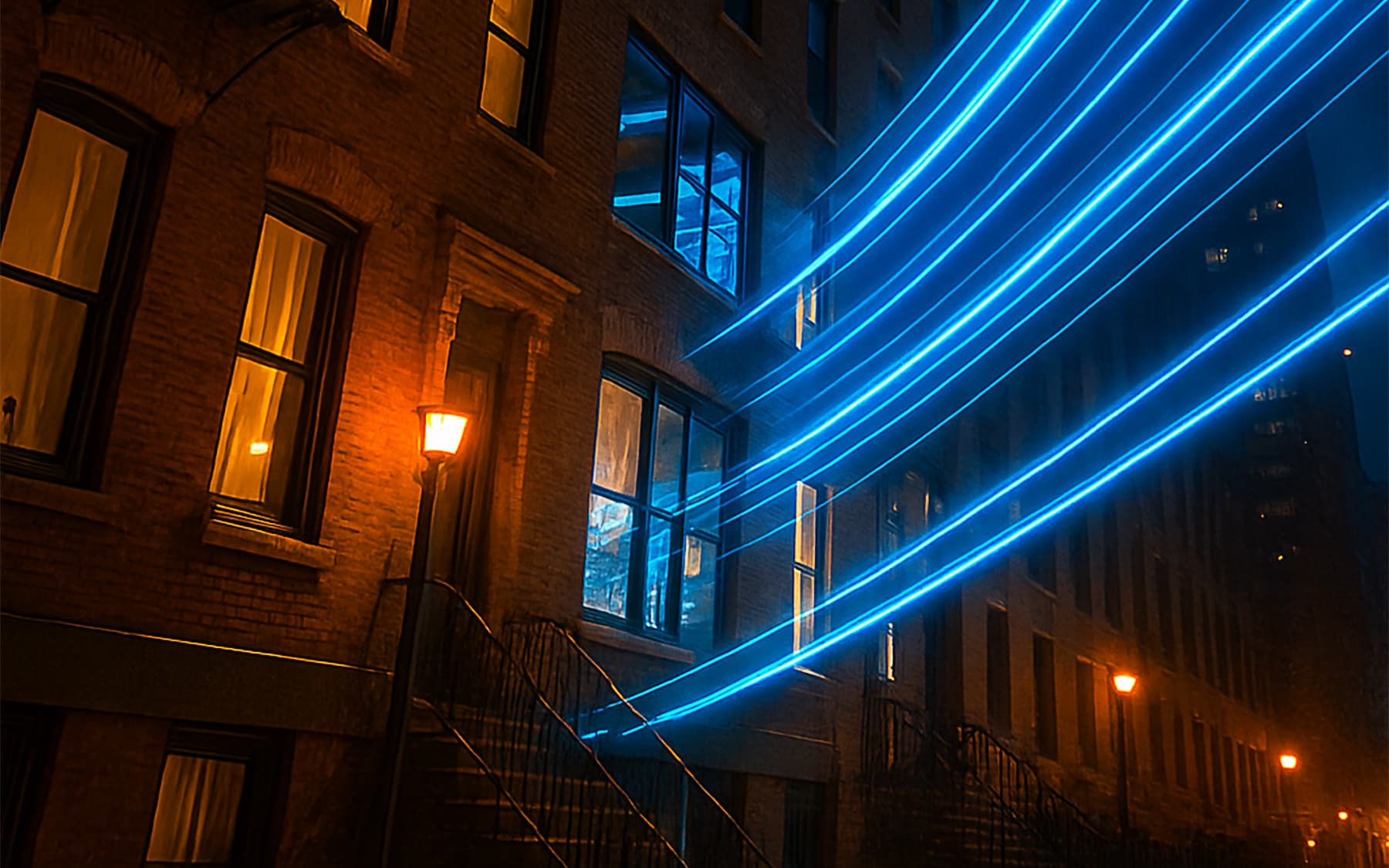How Is Fiber Internet Installed?
By: Vincent Totino
Read Time: 5 min.
March 20, 2025
Want to get more out of your home internet?
It’s only a relatively recent development that fiber optic Internet is more widely available. And if all you've ever known is DSL or cable, you're likely to be surprised when you experience something like Optimum fiber’s speed and reliability.
However, you may also find yourself curious about fiber Internet installation and what it entails. For instance: Is fiber Internet installed in the ground? Does it use a router? How do you prepare for an installation appointment?
In this guide, we'll explain the fiber optic installation process, covering everything from equipment and wiring to what happens during an installation appointment. Keep reading to learn more about how fiber optic Internet is installed.

What is Fiber Internet?
What is Fiber Internet?
Before understanding how fiber Internet is installed, it helps to know what it is. Unlike DSL or cable, which use copper wires, fiber optic Internet service relies on optical fiber to transmit data. These fiber optic cables, made of glass or plastic, use light pulses instead of electrical signals, enabling high-speed Internet with low latency and reliable Internet services.
At Optimum, our 8-gig fiber optic internet connection ensures fast upload and download speeds, WiFi 6E compatibility, and enhanced security.
Types of Fiber Internet Connection
The fiber cables that are necessary for fiber Internet can be wired in your house, but this isn't your only option. There are three core types of fiber Internet connections:
Fiber to the Home (FTTH): With FTTH, fiber optic cables run directly from your Internet service provider’s network to your house. Because it doesn’t require any copper wiring, FTTH offers the fastest Internet speeds.
Fiber to the Curb (FTTC): Here, the fiber cables stop at a pole or curb near your house. A coaxial cable is then used to bring the fiber Internet the remaining distance to your home. FTTC connections can be slower but are still considered more advanced than cable or DSL.
Fiber to the Neighborhood (FTTN): Also known as “Fiber to the Node,” with this type of connection, the fiber optic cables stop further away from your home. They run to a node, which is a connection hub near your neighborhood.
All homes in the area with fiber Internet are connected to this node via coaxial cable. In some cases, copper coaxial wiring must travel quite far to reach your house, which can result in slower speeds.
Does Your House Have to Be Wired for Fiber?
Equipment Needed For Fiber Internet
Switching from cable or DSL to fiber optic Internet service requires different equipment. Here's what you'll need:
- Fiber Optic Cables - hese thin strands, as fine as a human hair, are installed either underground or attached to utility poles.
- Clamshell - A protective utility box that houses the fiber optic cables where they connect to the optical network terminal.
- Optical Network Terminal (ONT) - Instead of a traditional modem, fiber requires an ONT, which converts light signals into digital data for your devices.
- Fiber Optic Router or Gateway - You’ll need a fiber-compatible router to ensure you get the maximum speed from your connection.
- WiFi Extenders - If your home has weak signals, WiFi extenders help expand reliable Internet connection throughout your space.
- Ethernet Cable - A high-speed Ethernet cable ensures wired connectivity for gaming, video calls, and large downloads.
Optimum Fiber customers receive a Gateway 6 with WiFi 6E technology for faster streaming, gaming, and working.
What Equipment Is Needed for Fiber-Optic Internet?
How to Prepare for a Fiber Internet Installation Appointment?
Your fiber Internet installation appointment will be professionally handled, but there are a few things you should do beforehand:
- Check Availability - Fiber service isn't available everywhere yet. Use our tool to confirm service in your area.
- Choose the Right Plan - Consider how much speed you need. Our fiber Internet plans range from 300 Mbps to 8 Gig.
- Schedule an Installation Appointment - Fiber Internet installation can take two to three hours, so plan your day accordingly.
Step-by-Step Fiber Optic Installation Process
Step 1: Pre Work home visit
Before your appointment, a technician may visit your property to better plan for your installation. If they do pay you a visit, all the work will be done outside-you don't need to be home.
Step 2: Technician arrival and fiber set-up
When your technician arrives, they can help you find the best location for your new equipment. Once you've picked a spot, they'll start on your installation. As we mentioned, this can take up to three hours from start to finish.
As part of the setup, your technician may need to drill a small hole to bring the fiber cable into your house. If possible, they'll avoid this by using an existing hole from a previous service set-up.
Step 3: Gateway installation
The technician will bring all the necessary equipment with them, including your new gateway (to replace your old modem and router). They will set it up as part of the installation.
Step 4: Signal test
To make sure you'll have WiFi throughout your entire home, the technician will perform a signal test. Based on the results, they'll determine if WiFi extenders are needed. If you do need extenders, your technician will install them during the same visit.
Step 5: Customer test
Once they've finished installing your fiber Internet, you'll get the chance to confirm that your services and equipment are working. The technician will share your new WiFi network name and password with you, and you can test them out.
After installation, if you so choose, you can change the name and password on your own. You can find a step-by-step tutorial on how to do so in the "After Installation" section of Optimum's Fiber Internet installation page.
Step 6: Appointment conclusion
Before your technician leaves, they'll have you sign the work order. Afterward, you'll receive an email with a copy of it for your records. If you were previously an Optimum Internet customer (but didn't have fiber), the technician will also take your old equipment with them and remove it from your account. They'll note this in the work order before you sign it.
Now that you know how fiber Internet gets installed, learn how to get Internet access when you’re away from home.
Read our article on staying connected to WiFi—anywhere for all the details.
How Do You Prepare for Fiber Optic Installation?
How To Get Optimum Fiber Internet Installed at Your Home
Have a question about Optimum Internet service? Explore our Frequently Asked Questions page or contact us for





